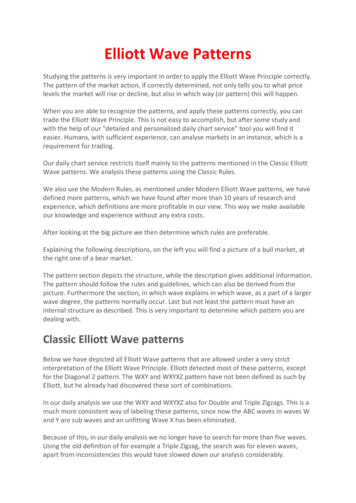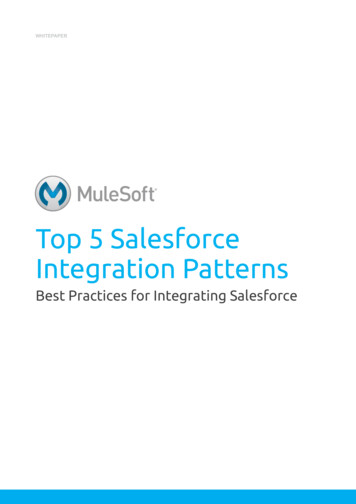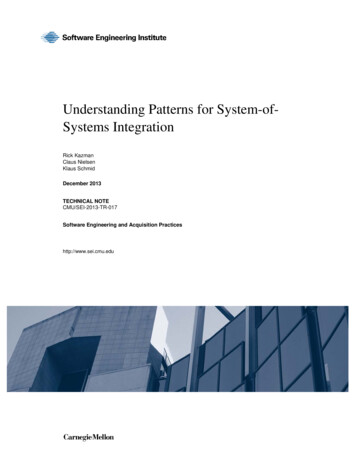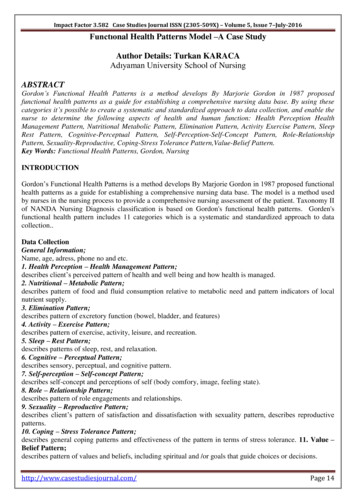
Transcription
ShiftingpatternsThe future ofthe logisticsindustryPwC’s futurein sight serieswww.pwc.com/transport
ContentsThe trick to seeing the future.is knowing where to look for it.PwC’s future in sight series bringstogether our insights and perspectiveson the disruptive forces we believewill have a transformative impacton the future.www.pwc.com/futureinsight2 Shifting patternsExecutive summary 2Introduction 3Disruption and uncertainty 5Changing customer expectations 5Technological breakthroughs 6New entrants to the industry 8Redefining collaboration 9Logistics scenarios 111. Sharing the PI(e) 122. Start-up, shake-up 133. Complex competition 144. Scale matters 15Leading through uncertainty 16Learn more 17
Executive summaryLike most other industries, transportation and logistics (T&L) iscurrently confronting immense change; and like all change, this bringsboth risk and opportunity. New technology, new market entrants, newcustomer expectations, and new business models. There are many waysthe sector could develop to meet these challenges, some evolutionary,others more revolutionary. In this paper we discuss four key areas ofdisruption logistics companies need to focus on now, and explore somepossible futures of the industry.Four areas of disruptionCustomer expectations are increasinggreatly. Both individuals and businessesexpect to get goods faster, more flexibly,and – in the case of consumers – at lowor no delivery cost. Manufacturing isbecoming more and more customised,which is good for customers but hardwork for the logistics industry. Add itall up and the sector is under acute andgrowing pressure to deliver a betterservice at an ever lower cost.It can only hope to do this by makingmaximum and intelligent use oftechnology, from data analytics, toautomation, to the ‘Physical Internet’.This promises lower costs, improvedefficiency, and the opportunity to makegenuine breakthroughs in the way theindustry works. But ‘digital fitness’is a challenge for the sector, which iscurrently lagging many of its customersin this respect. Attracting the right skillsis one issue, but developing the rightstrategy is even more crucial.An increasingly competitiveenvironment is another big factor in themix. Some of the sector’s own customersare starting up logistics operations oftheir own, and new entrants to theindustry are finding ways to carve outthe more lucrative elements of the valuechain by exploiting digital technology ornew ‘sharing’ business models, and theydon’t have asset-heavy balance sheets orcumbersome existing systems weighingthem down.‘Sharing’ is a big story for logisticsnow – from Uber-style approachesto last-mile delivery, to more formalJVs and partnerships at corporatelevel, the whole sector is redefiningcollaboration. But much of thisis hampered by inconsistenciesin everything like shipment sizes,processes or IT systems. The PhysicalInternet promises great things for thesector, coming along with increasedstandardisation in logistics operations.Possible futuresWhat will the logistics marketplace looklike in five to ten years? That’s still avery open question. We took a closerlook at how some of the key disruptionsfacing the industry may interact. Thefuture scenarios we explore involvecombinations of these four factors,weighted according to how importantspecific trends become:Sharing the PI(e): the dominanttheme in this scenario is the growth ofcollaborative working, which allows thecurrent market leaders to retain theirdominance. This could for example seea greater use of ‘Physical Internet’ (or‘PI’) solutions, based on a move towardsmore standardised shipment sizes,labelling and systems.Start-up, shake up: in this scenarionew entrants in the form of startups make a bigger impact. The mostchallenging and costly last mile ofdelivery, in particular, becomes morefragmented, exploiting new technologieslike platform and crowd-sharingsolutions. These start-ups collaboratewith incumbents and complement theirservice offers.Complex competition: here thecompetitive set evolves in a differentdirection, as large industrial or retailcustomers and suppliers become playersin the logistics market themselves, notjust managing their own logistics butturning that expertise into a profitablebusiness model.Scale matters: and finally, in thisscenario, the current market leaderscompete for a dominant market positionby acquiring smaller players, achievingscale through consolidation, andinnovation through the acquisition ofsmaller entrepreneurial start-ups.We hope this paper will help you assessthe trends and developments most likelyto affect your own business, and start todevelop a strategy to ensure continuedprofitability through this time of intensechange.The future of the logistics industry3
IntroductionLogistics companies are facing an era of unprecedented changeas digitisation takes hold and customer expectations evolve. Newtechnologies are enabling greater efficiency and more collaborativeoperating models; they’re also re-shaping the marketplace in ways thatare only just beginning to become apparent. New entrants, whether theybe start-ups or the industry’s own customers and suppliers, are alsoshaking up the sector.The race is on to define the industry’sfuture. And with an estimated US 4.6trillion1 of revenues at stake, companiescan’t afford to sit back and watch; theyneed to adapt to changing marketsproactively.We’ve developed a transformationframework to describe how megatrends2affect a given industry, taking intoaccount the key disrupting forcesthat create uncertainties for everyorganisation in the sector. Based onthese uncertainties, we outline distinctscenarios to explore possible futuresfor the sector. This framework will helpyou plan for this uncertain and volatilefuture.3For the logistics industry, we startby taking a closer look at some ofthe key disrupting factors: changingcustomer expectations, technologicalbreakthroughs, new entrants to theindustry, and new ways to competeor collaborate. These disruptionshave very different implications forindividual companies, depending onwhich segments they operate in, theirtype of ownership, and where theyare located. They also don’t exist in avacuum: in each case, the interactionsbetween them are equally, if not more,important. Government interventionand trade flows between regions andterritories are influencing the industrytoo, but very much depend on nationalpolitics and geography.1 search/Note: various estimates available, high variance, distinct approaches, difficult to measure given insourced and outsourced portions of the total market2 symposium/2014-megatrends-overview.pdf3 At PwC, we are analysing potential futures for various industry sectors and some papers are already published (see list on page 20).4 Shifting patterns
Defining ‘Logistics’ for this paperThere are a number of distinct business models in the industry, although they canoverlap, and individual companies may operate under more than one model. In thispaper, we consider logistics service providers (LSP), carriers, and courier / express /parcel (CEP) companies. Postal operators, too, are relevant players in the context oflogistics and CEP.Not only business models but profitability and margins differ considerably. Incontrast with other industries, profits in logistics are relatively low. Yet, within thissector, EBIT margins generally range from -1% to 8%. While carriers find themselvesclose to zero profit, sometimes even in the red, the large CEP companies end upbeing the most profitable group, sometimes reaching double-digit profit margins.4Customers in the logistics industry comprise of both B2B and B2C segments. Themajor part of the total market can be linked to B2B transactions, with LSPs andcarriers accounting for the biggest portion of industry revenue. CEP represents asmaller, but faster growing segment; and just about a third of CEP revenues can beattributed to B2C.SegmentB2BB2CBusinessModelCustomerLSPFreight forwarders, 3rd and 4th partylogistics service providersManufacturers,wholesalers, and retailersCarriersTrucking, rail freight, sea freight andair freight companiesLSPsCEPCourier / Express / Parcel companiesRetailers, manufacturers,and other companiesCEPCourier / Express / Parcel companiesPrivate consumersOur four logistics scenarios for thefuture of the industry are basedprimarily on the different wayscollaboration and competition couldevolve within the sector: Sharing the PI(e): the dominanttheme in this scenario is the growthof collaborative working, whichallows the current market leaders toretain their dominance. This couldfor example see a greater use of‘Physical Internet’ (or ‘PI’)5 solutions,based on a move towards morestandardised shipment sizes, labellingand systems. Start-up, shake up: in this scenarionew entrants in the form of startups make a bigger impact. The mostchallenging and costly ‘last mile’of delivery, in particular, becomesmore fragmented, exploiting newtechnologies like cloud platformsand crowd-sharing. These start-upscollaborate with incumbents andcomplement their service offers. Complex competition: here thecompetitive set evolves in a differentdirection, as large industrial or retailcustomers and suppliers becomeplayers in the logistics marketthemselves, not just managingtheir own logistics but turning thatexpertise into a profitable businessmodel. Scale matters: and finally, inthis scenario, the current marketleaders compete for a dominantmarket position by acquiring smallerplayers, achieving scale throughconsolidation, and innovationthrough the acquisition of smallerentrepreneurial start-ups.Together these logistics scenarios mapout a range of possibilities for thecontext in which every company willneed to compete in the future. Thatin turn provides a basis for evaluatinghow resilient and ‘fit for growth’ currentstrategies and plans are.Regardless of whether one logisticsscenario comes closest to the truthfor your segment of logistics andgeographical environment, or whetheryour future combines elements fromseveral, each company will need toadapt their current strategy to cope.That may mean reassessing businessmodels, the operating model andcapabilities, HR strategies, financialperformance, and the organisation’spurpose. We suggest some possibledirections in our final chapter. Moredetailed views on particular regions,segments and capabilities are still tocome in later articles.4 Strategy& analysis (peer groups of listed companies in each segment; average EBIT margins of the past 5 financial years)5 The term ‘PI(e)’ is here built into the phrase ‘Sharing the pie’, but also alludes to the Physical Internet, often referred to as ‘PI’; for more detail see page 9The future of the logistics industry5
Disruption and uncertaintyChanging customerexpectationsLike individual consumers,industrial customers nowexpect to get shipments faster,more flexibly, and with moretransparency at a lower price.No surprise that across theindustry, both operatingmodels and profitability areunder strain. And the paceof transformation for largemanufacturing and retailcustomers may turn out to beeven faster than for privatefinal consumers.B2B: Striving for efficiency andtransparencyManufacturing industries are facing fargreater expectations around efficiencyand performance than ever before. Theircustomers expect faster time-to-market,reduced defect rates and customisedproducts. Ultimately, the result maybe a goal that was once impossible: a‘lot size of one’, where each product ismanufactured to the specifications of aspecific end-customer. The advent of theindustrial Internet of Things and whatother research refers to as ‘Industry 4.0’is allowing manufacturing companies,whether they make industrialequipment, cars, planes, or consumergoods, to redefine everything from theway they interact with customers to howthey structure supply chains.67All this has huge implications fortransportation and logistics. LSPs – inparticular 3PLs and 4PLs – need tointegrate data analytics and socialsupply chains to provide muchbetter traceability and predictability(not to mention lower costs); smartwarehousing solutions will becomeessential. The implications are clear:‘digital fitness’ is becoming a must forevery logistics company.B2C: New shopping patternsMany logistics companies also serve B2Ccustomers. Consumers went digital longbefore many of the retailers, and someparts of the sector are still strugglingto keep up. The leading players areadopting what we call ‘total retail’,which is an operating model acrossbricks and mortar, online mobile andother retail channels.6 Total retail iscomplemented by ‘connected retail’,where retailers aim to create a seamlessbrand experience for the customeracross personalised marketing, thephysical store, the digital experience,and the payment options, all of it drivenby a strong coherent brand.7 Whatare the consequences for the C, Connected Retail: Reshaping tomorrow’s operating model and metrics, 20156 Shifting patternsShippers aren’t generally part of abranded retail experience. Most privateend-consumers are what we call‘shipper-agnostic’: they don’t care whodelivers their goods, as long as theyget them reliably, quickly and cheaply.Many want more flexible delivery –whether in terms of when or wherethey get their goods - and most aren’twilling to pay for shipping: they expectit to be free, though they are prepared topay a premium for additional services,such as faster delivery for high-valueitems. There’s also currently a lowacceptance of dynamic pricing forparcels; customers expect to pay thesame price for shipping regardless ofseasonal capacity constraints faced bytheir shipper, with the exception ofsurcharges for same day, overnight orexpedited service.
TechnologicalbreakthroughsTechnology is changingevery aspect of how logisticscompanies operate. ‘Digitalfitness’ will be a prerequisitefor success: the winners willbe those who understand howto exploit a whole range ofnew technologies, from dataanalytics to automation andplatform solutions. Those whodon’t, risk obsolescence. Butwith so many technologiescompeting for managementattention and investment,defining a clear digitalstrategy that’s integratedinto business strategy will becritical.themselves as ‘advanced’ on digitisationwas just 28%. Some of the industry’scustomers are already well ahead ofthis – 41% of automotive companies and45% of electronics companies alreadysee themselves as advanced. The lack ofa ‘digital culture’ and training is thus thebiggest challenge for transportation andlogistics companies. T&L firms are inline with other industries in planning toinvest 5%9 of their revenues per annumuntil 2020, but the next few years willbe critical: companies that don’t startsoon risk being left behind permanently.Cloud technology can enable platformsolutions, which in turns makes itpossible to use new business models,such as ‘virtual freight forwarding’.It can also provide flexibility andscalability, as well as standardisedand harmonised processes across thewhole organisation. That’s especiallyimportant for those LSPs or carriers whohave grown through acquisitions, andcurrently rely on a patchwork of legacysystems.The potential is huge, but the industryhas thus far been slow to seize it. Inour recent Industry 4.0 study, thepercentage of T&L companies that ratedFigure 1: L ack of digital culture and training is the biggestchallenge facing transportation and logistics companies&cs as corealyticapAnabilion and iisat and h ntegratilgoDi ertica e cha rizon tiins tv valugid tis a tse i o n o fr vice offeringsofon la1.itytaulb m2g it a tom od . D i d cuse ls a n50%&siner e s saccessAnalytic s aDi3. t ancpro dulbipacas c oreit ytaDaThere is no other industry where somany industry experts ascribe a highimportance to data and analytics inthe next five years than transportationand logistics – 90% in T&L comparedto an average of 83%.8 The sector hasnever had access to more data. Thereare vast opportunities here to improveperformance and serve customers better,and LSPs who are part of a digitallyintegrated value chain can benefit fromsignificantly improved forecasting toscale capacity up or down and planroutes. Adding machine learning andartificial intelligence techniques to dataanalytics can deliver truly dynamicrouting.DaDigital is still a challenge for thesectorLack of digital culture and trainingUnresolved questions around data security and dataprivacy in connection with the use of external data38%High financial investment requirements38%Lack of a clear digital operations vision andsupport / leadership from top management33%26%Insufficient talentSlow expansion of basic infrastructure technologies23%Business partners are not able tocollaborate around digital solutions22%21%Unclear economic benefit of digital investmentsLack of digital standards, norms and certificationConcerns around loss of control over yourcompany’s intellectual property17%15%Note: Included as one of three possible responsesQ: Where are the biggest challenges or inhibitors for building digital operationscapabilities in your company?Source: rprise-april-2016.pdfIbid.The future of the logistics industry7
processing and optics now allow tasks tobe automated which were once thoughttoo complex – like trailer loading andoffloading at acceptable speeds.Automation could reshape theworkforceLabour is a critical element of anylogistics operating model, and up tillnow there’s always been a trade-offbetween service levels and costs. Butautomation breaks down this equation,allowing firms to offer better serviceand save money at the same time.Some of the industry’s most labourintensive processes are on the way tobeing fully or partially automated, fromwarehousing to last-mile delivery.Automated solutions in the warehouseare already being implemented andtheir level of sophistication is increasing.For example, automated loading andunloading systems are already available,but in the future these are likely to beable to bypass obstacles and adjustroutes automatically. Advances in dataThe technology10Package delivery could also make moreuse of automation, through innovationslike autonomous vehicles or deliverydrones. Google has already startedworking on self-driving lockers andthe trucking industry is partneringwith OEMs on partially automatedtruck convoys. Even if more radicalsolutions are a long time coming, othertechnologies which could make driversmore efficient are in the offing too, likeaugmented reality solutions that givedrivers more information about theirenvironment and the packages still onboard.We’ve mapped out some of the mostimportant technologies in the tablefacing this page. The rate of adoptionof any of the technology opportunitiesdiscussed here will not be limited bytechnical advancement rate. Instead itwill be driven by the rates of regulatoryand customer acceptance.The impactThe uncertaintiesPhysical Internet(based on the IoT) Improved supply chain transparency, safety andefficiency Improved environmental sustainability (more efficientresource planning) Social expectations around data privacy and security maychange Regulation around data security and privacy may increaseor be enforced more stringently The sector’s willingness and ability to invest in collaboration Whether international bodies will drive standardisationIT standards Enabling collaboration horizontally More efficiency and transparency Companies’ willingness to adopt is uncertain due to datasecurity concernsData analytics Improvements in customer experience andoperational efficiency in operations Greater inventory visibility and management Improved ‘predictive maintenance’ Rate of development of data processing capacity is unclear Question marks around data security Social expectations around data privacy and security maychange Regulation of data security and privacy may increase or beenforced more stringentlyCloud Enabling new platform-based business models andincreasing efficiency Development of costs unclear (once a certain scale isreached physical data centres still tend to be cheaper) Uncertainties around data securityBlockchain Enhanced supply chain security (reduction of fraud) Reduction in bottlenecks (certification by 3rd parties) Reduction of errors (no more paper-baseddocumentation) Increased efficiency Rate of adoption uncertain Unclear whether one or two dominant solutions will emergeor multiple competing solutionsRobotics &automation Reduction in human workforce and increasedefficiency in delivery and warehousing (includingsorting and distribution centres) Lower costs Speed of technology development unclearAutonomousvehicles Reduction in human workforce Increased efficiency in delivery processes Regulatory environments not currently in place in mostcountries Liability issues not yet clear Ethical questions remain especially in relation to emergencysituationsUAVs / Drones Increased cost efficiency (use cases: inventory,surveillance, delivery) Workforce reduction Regulation in most countries not sufficient for commercialuse in public areas like delivery Safety and privacy concerns may hamper marketacceptance3-d printing Lower transportation demand Transported goods would mostly be raw materials Speed, scale, and scope of uptake by customer industriesstill unclear10 For a list of PwC publications on these technologies please refer to page 188 Shifting patterns
New entrants to theindustryPlatform technology has givenrise to new business models,often driven by start-ups thatenter the logistics industry.New ‘sharing’ business modelscould have as much of animpact on the sector as newtechnology. And the industry’scurrent customers andsuppliers may end up being thebiggest new entrants.Start-ups drive new businessmodelsMost of the new entrants to thelogistics sector are start-ups, andmany of these are looking to use newtechnology to enter the industry. Todate most of these are in ‘asset light’parts of the value chain; for example,virtual freight forwarders. These assetless or asset-light businesses exploitdigital technology to offer interactivebenchmarking of freight rates, or matchshippers with available capacity.Many of the new entrants in freightforwarding are basing their offeringon more agile pricing. Some enablecarriers to bid on loads, allowing themto lower their bids in order to fill upcapacity. They’re also providing quotesmore quickly and increasing pricetransparency – for example, by linkingvia API directly to a large number ofcarriers, and providing customers withtheir negotiated rates for each of thecarriers they use so they can comparedirectly.Last-mile delivery has also seen a waveof start-ups in recent years. Some ofthese companies are using technologyto tap into the ‘sharing economy’ bymatching available capacity withdelivery needs. Uber, currently thelargest crowd-sharing platform forpassenger transit, has its eye on thelogistics markets too. It has establishedan UberCARGO van service in HongKong11, and UberRUSH is offeringexpress services by targeting onlineretailers.12 Dolly, another start-upheadquartered in the US, has a similar111213141516171819approach and helps people to getthings transported within their cityby connecting them with registereddrivers.13 Norwegian start-up Nimbermatches commuters and travellers withconsumers looking to ship something,whether it be a piano across the countryor a skateboard or document acrosstown.14How are traditional logistics companiescountering these developments? Theyknow they need to explore opportunitiesfor new products and services – a fieldwhere start-ups have a clear advantagegiven their freedom from outmodedprocesses and hierarchical structures.Yet investments by traditional LSPs indigital logistics start-ups only constitutearound 6% of overall venture capitalflows.Start-ups aren’t the only newentrantsMajor players from other industries mayhave even more potential to shake upthe industry’s competitive dynamics.Autonomous vehicles are one possibleexample: technology players, ortechnology-automotive collaborationsmay enter the industry, especiallywith ideas like self-driving lockers, ormachine-to-machine parcel-stationloading for last-mile delivery. Crowdsharing platforms may also emerge fromautonomous vehicle development, orindependently. As car-sharing increases,so may the use of the storage spaceavailable in these vehicles as a flexibleway to expand capacity.The industry’s own customers mayalso become significant new entrants.Amazon is an obvious example: it’slooking to expand its in-house expertisein warehousing as well as develop itsown delivery capabilities. Hence itsacquisition of a warehouse automationspecialist, now part of its AmazonRobotics business unit. The company hasleased 20 aircrafts to handle more of itsown shipments15, and is piloting a ‘PrimeAir’ 30-minute delivery offering usingdrones.16 Bloomberg has also reportedthat Amazon has plans to launch its ownlogistics offerings, a project, allegedlyreferred to as ‘Dragon Boat’.In Asia, Alibaba is trying to improvedelivery services for its sellers bysetting up Cainiao, a JV with severallogistics companies, a department store,an investment firm and a companywith port logistics operations.17 Themain advantage for network membersconstitutes the access to a logisticsdata platform, which helps them toachieve efficiencies in order fulfilmentby leveraging their capacity andcapabilities at a large scale.18 And thecompany is trying out new ideas too,like an app that allows consumers torequest a pick-up of a return or packagefrom delivery personnel in the area.19Figure 2: Venture capital flows into digital logistics startupssince 2011*Private equity flows US 150mFlows fromlegacy logisticscompanies US 10m* Totals are not exhaustive. Our estimates of capital flows are based on analysis of mostprominent and publicised startups.Source: Strategy& analysis based on Bloomberg and Crunchbase on.com/b?ie UTF8&node //hsprod.investis.com/ir/alibaba/2016 Alibaba 20-F.pdfIbid.The future of the logistics industry9
RedefiningcollaborationCollaboration andstandardisation would increaseefficiencyHorizontal collaboration isalready happening, especiallyin last-mile delivery, but it’shampered by inconsistencies.Higher levels of efficiencycould be achieved by moreconsistent standards, definedthrough the Physical Internetand increased collaboration,whether in the form ofalliances, joint ventures orM&A.For many industries, the standardassumption is that a larger number ofcompetitors is beneficial for customers.However, in certain logistics sectors,there are substantial benefits in havingmore consolidation, not less. Accordingto one estimate, a 10% to 30% increasein efficiency in the EU logistics sectorwould translate into 100-300 billionin cost savings for European industry.20The Physical Internet could help addressthis ‘grand challenge’ by drasticallyincreasing co-operation betweencompanies and across transport modesthrough greater standardisation (seeinfo box ‘From manifesto to reality’).Building on last-mile partnershipsThere are already notable examples ofmarket players operating collaboratively.Companies like FedEx and DHL havebeen partnering with national postalcompanies and small local players formany years. But with the advent of newtechnology, collaboration can becomemuch more dynamic.However, fragmentation, accountability,and a lack of consistency makecollaboration more difficult. Forexample, each company has its ownlabelling system, and some companiesare wary of farming out the cruciallast mile of the journey to an operatorthat may not reflect its own brand andservice levels. And aside from the lastmile, partnering agreements are theexception, rather than the rule. Takefreight forwarding. While containers area standard size, the packages that gointo them aren’t. Nor are the forms anddigital entries used to clear customs.Contract logistics companies co-operateextensively with shippers, but oftendon’t share resources with competitors.For the Physical Internet to work inpractice, though, companies would needto be willing to collaborate far moreextensively than they do today. Most ofthe 535,000 distribution centres in theUS are standalone operations ownedby different companies; imagine thesavings if they were all connected, andphysical workflows were standardisedfor maximum efficiency.There are many other less radical waysfor logistics companies to use assetsmore efficiently by collaborating.For example, by sharing fleets andnetworks, and establishing agreementssimilar to the airlift purchased by postalagencies from commercial couriers, orthe code-sharing used by airlines. DBSchenker, for example, recently signed afive-year contract with the online freightexchange provider uShip, to develop aplatform to connect truck drivers andshipments more efficiently.21Many companies in the sector arealso turning to M&A, joint ventures,and alliances as a way to achievecollaboration. In 2015, M&A deal valuenearly doubled compared to 2014,with much of this activity driven bylarge players looking to expand theirinternational operations and servic
profitability through this time of intense change. 4 Shifting patterns Introduction Logistics companies are facing an era of unprecedented change as digitisation takes hold and customer expectations evolve. New technologi










